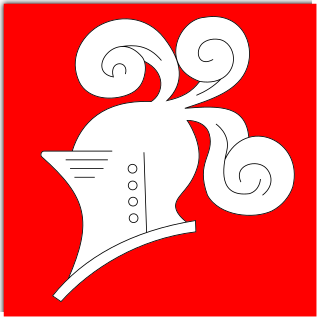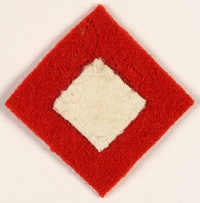
Operation Compass was the first large British military operation of the Western Desert Campaign (1940–1943) during the Second World War. British, Empire and Commonwealth forces attacked Italian forces of the 10th Army in western Egypt and Cyrenaica, the eastern province of Libya, from December 1940 to February 1941.

Operation Sonnenblume was the name given to the dispatch of German troops to North Africa in February 1941, during the Second World War. The Italian 10th Army had been destroyed by the British, Commonwealth, Empire and Allied Western Desert Force attacks during Operation Compass (9 December 1940 – 9 February 1941). The first units of the new Deutsches Afrikakorps departed Naples for Africa and arrived on 11 February 1941. On 14 February, advanced units of the 5th Light Afrika Division, Aufklärungsbataillon 3 and Panzerjägerabteilung 39 arrived in Tripoli, Libya and were sent immediately to the front line east of Sirte.

The 2nd Armoured Division was a division of the British Army that was active during the early stages of the Second World War. The division's creation had been discussed since the beginning of 1939, with the intent to form it by splitting the 1st Armoured Division. A lack of tanks delayed this until December 1939. For a short period after its creation, the division had no assigned units until the 1st Light Armoured Brigade was assigned to it from the 1st Armoured Division, and the 22nd Heavy Armoured Brigade from Southern Command.

The 6th Armoured Division was an armoured division of the British Army, created in September 1940 during the Second World War and re-formed in May 1951 in the UK.

The 23rd Armoured Brigade, originally formed as the 23rd Army Tank Brigade, was an armoured brigade of the British Army that saw service during the Second World War. The brigade was a 2nd Line Territorial Army (TA) formation. It was reorganised and renamed the 23rd Armoured Brigade, when it was assigned to the 8th Armoured Division, although it never operated under command of the division.

The 8th Armoured Division was an armoured division of the British Army during the Second World War. It was deployed to Egypt in June 1942 but never operated as a complete formation and was disbanded in January the following year.

The 9th Armoured Division was an armoured division of the British Army, raised during the Second World War. It never saw active service during the war as a complete division.

The 22nd Armoured Brigade was an armoured brigade of the British Army that saw service during and after the Second World War. The brigade was formed on the outbreak of war on 3 September 1939 from Territorial Army (TA) armoured regiments. It saw a considerable amount of action during the war, beginning with the Western Desert Campaign where it was engaged in Operation Crusader and at the Battles of Gazala, Mersa Matruh, First Alamein and Alam el Halfa. It then joined the 7th Armoured Division for the Second Battle of El Alamein. It remained part of 7th Armoured for the rest of the war, including the campaigns in Tunisia, Italy and North West Europe. It continued in the postwar TA until 1956. The brigade's identity was re-established in the Regular Army between 1981 and 1993.

The 8th Armoured Brigade was an armoured brigade of the British Army formed in August 1941, during the Second World War and active until 1956. The brigade was formed by the renaming of 6th Cavalry Brigade, when the 1st Cavalry Division based in Palestine converted from a motorised formation to an armoured unit, becoming 10th Armoured Division.

The 10th Armoured Division was an armoured formation of division-size of the British Army, raised during the Second World War and was active from 1941–1944 and after the war from 1956–1957. It was formed from the 1st Cavalry Division, a 1st Line Yeomanry unit of the Territorial Army (TA) which had previously been serving in Palestine. The division was converted from cavalry to armour and redesignated from 1 August 1941.

The 42nd Armoured Division was an armoured division of the British Army raised during the Second World War.
The 1st Armoured Brigade, raised as the 1st Light Armoured, later the 1st Armoured Brigade Group, was an armoured formation of the British Army.
Operation Battleaxe was a British Army offensive during the Second World War to raise the Siege of Tobruk and re-capture eastern Cyrenaica from German and Italian forces. The offensive's failure led to the replacement of British General Sir Archibald Wavell, Commander-in-Chief Middle East, by Claude Auchinleck; Wavell took Auchinleck's position as Commander-in-Chief, India.
The Order of battle of the East African campaign shows the ground forces of both sides in East Africa on the date that the Italians declared war on Britain and France, 10 June 1940 and for the British and Commonwealth forces involved in the 1941 offensive.
This is the order of battle for the Battle of Villers-Bocage, a World War II battle on 13 June 1944 between British and German forces in Normandy, France as part of Operation Perch.

This is the order of battle for the Battle of Alam el Halfa, a World War II battle between the British Commonwealth and the European Axis Powers Germany and Italy in North Africa between 30 August and 5 September 1942.
This is the order of battle for the ground forces involved in Operation Crusader, a World War II battle between the British Commonwealth and the European Axis Powers of Germany and Italy in North Africa between 18 November – 30 December 1941.












